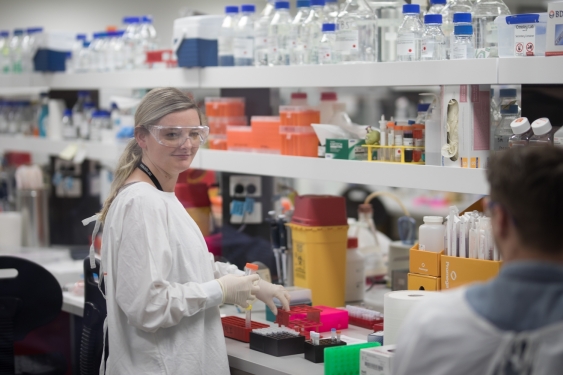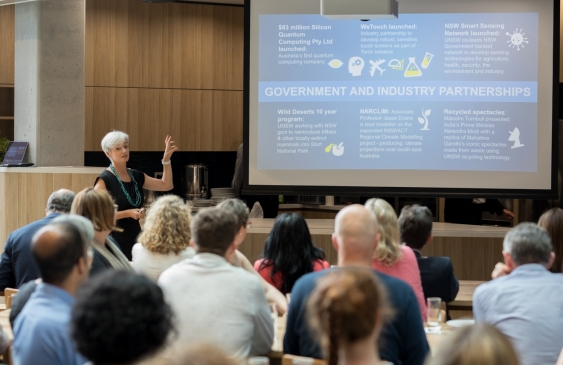UNSW Science targets Guinness World Record
As part of its inaugural Faculty Showcase Day, UNSW Science held a fun attempt to break the Guinness World Record for the largest gathering of people dressed as scientists.
As part of its inaugural Faculty Showcase Day, UNSW Science held a fun attempt to break the Guinness World Record for the largest gathering of people dressed as scientists.

As part of its inaugural Faculty Showcase Day on Monday 27 November, UNSW Science held a fun attempt to break the Guinness World Record for the largest gathering of people dressed as scientists.
More than 900 people took part, which could be enough to break the record, but any final decision is subject to official scrutiny. For the record attempt, people had to wear a lab coat, lab glasses and hold a piece of lab equipment.
But the main aim of the event was also to break a stereotype about scientists, and show they are a diverse group. So, a second photo was taken without lab coats on.
“It was amazing to look down University Mall and a see a sea of white,” said UNSW Science Dean Professor Emma Johnston, “and then watch as they took off their coats and revealed themselves as the diverse array of researchers we know them to be.
“It was a fantastic way to end our showcase, with the whole UNSW community coming together to reflect the strength of our scientific endeavour.”
UNSW is a powerhouse for scientific learning and research. Each year, it is the university of choice for thousands of the brightest students from around the world who want to learn from award-winning academics, access cutting-edge facilities and connect with industry leaders.

PhD and research students share the new PC2 certified research laboratory. Photo: Supplied
The Faculty Showcase kicked off with an interactive tour of the newly constructed $125 million Biosciences Building, which features impressive six-floor central atriums to the sky for natural light throughout. Through UNSW’s partnership with the Australian Museum, a whale skeleton has been offered for suspension, and there are plans for a timeline display outlining the history of research completed by UNSW Science, providing a grand entrance for students.
Professor Martin Van Kranendonk from the School of Biological, Earth & Environmental Sciences (BEES) led guests through some of the state-of-the-art teaching labs, and presented on the achievements of the BEES School over the past year, along with insightful presentations from researchers.
“BEES is a very large school, with more than 100 academics, and an annual research income of $21 million per annum,” Professor Van Kranendonk said.
“In terms of our research income, in the recent funding round we had 10 ARC Discovery projects announced for BEES alone, which is unheard of in terms of numbers, a total of $3.3 million.
“We are much more than a local or regional school, we don’t only study Australia, we study the whole world. We have researchers who work around the globe and we are ranked 15th in the QS World University Rankings in Environmental Sciences globally.”
Professor Andrew Brown from the School of Biotechnology & Biomolecular Sciences then took guests through the new state-of-the-art molecular biology laboratory and its leading-edge technology, and onto the new PC2 certified research laboratory – a completely decontaminated and contained environment where PhD students and researchers can pool their resources and integrate with each other, while working on nine different research projects.

Dean of Science Professor Emma Johnston launches the new Science Strategic Plan. Photo: Supplied
Professor Johnston provided an overview of the Science faculty’s achievements for 2017 and launched the new Science Strategic Plan under the auspices of the UNSW 2025 Strategy, outlining a scalable strategic vision, strategic investments and a global research impact.
“Over the next couple of years, we will be optimising our education experience, which means having a really thorough look at the whole education delivery from the Science faculty. A new initiative in the strategy is the UNSW Science for Policy Institute, which aims to enable our science, our discoveries, our innovations to more easily and more rapidly impact policy right from the beginning,” Professor Johnston said.
“The Science faculty has the largest footprint across UNSW of any of the faculties, so it is very important for us to create identities and to create intellectual communities in our different precincts to ensure people can work together.”
The showcase program continued with a series of researcher talks from each of the nine schools in Science, providing a brief snapshot on the following research projects: